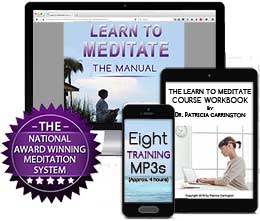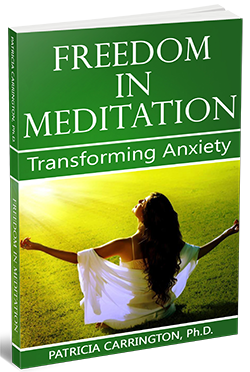List of Research Studies on Mantra Meditation
(Presented in alphabetical order, by lead author)
Alexander, C.N., Walton, K.G., & Goodman, R.S. (2003). Walpole study of the Transcendental Meditation Program in maximum security prisoners 1: cross- sectional differences in development and psychopathology. Journal of Offender Rehabilitation, 36, (1-4): 97-125.
Anklesaria, F.K., & King, M.S. (2003). Section IV: Transcendental Meditation in prisons and prison systems. The Transcendental Meditation program in the Senegalese penitentiary system. Journal of Offender Rehabilitation, 36 (1-4): 303-318.
Allison, J. (1970). Respiratory changes during the practice of transcendental meditation. Lancet, 7651833-834.
Appelle, S., & Oswald, L. E. (1974). Simple reaction time as a function of alertness and prior mental activity. Perceptual and Motor Skills, 38, 1263-1268.
Banquet, J. (1973). Spectral analysis of the EEG in meditation. Electroencephalography and Clinical Neurophysiology, 35, 143-151.
Barnes, V.A. (1997). Reduced cardiovascular and all-cause mortality in older African-Americans practicing the Transcendental Meditation Program. Unpublished doctoral dissertation, Dissertation Abstracts International: Section B: The Sciences and Engineering, 57 (8B) 4999.
Benson, H. (1975). The relaxation response. New York: Morrow.
Benson, H. (1977). Systemic hypertension and the relaxation response. New England Journal of Medicine, 296, 1152-1156.
Benson, H. (1989). The relaxation response and norepinephrine: A new study illuminates mechanisms. Australian Journal of Clinical Hypnotherapy and Hypnosis, 10(2), 91-96.
Benson, H., Alexander, S., & Feldman, C. L. (1975). Decreased premature ventricular contractions through use of the relaxation response in patients with stable ischaemic heart disease. Lancet, ii, 380.
Benson, H., & Wallace, R. K. (1971). Decreased drug abuse with transcendental meditation: A study of 1,862 subjects. Congressional Record, 92nd Congress, First Session, Serial No. 92-1.
Benson, H., Wilcher, M., Greenberg, B., Huggins, E., & Ennis, M. (2000). Academic performance among middle-school students after exposure to a relaxation response curriculum. Journal of Research and Development in Education, 33 (3): 156-165.
Carrington, P. (1998). The Book of Meditation. Patricia Carrington, Ph.D., NJ.
Carrington, P., Collings, G. H., Benson, H., Robinson, H., Wood, L. W., Lehrer, P. M., Woolfolk, R. L., & Cole, J. W. (1980). The use of meditation-relaxation techniques for the management of stress in a working population. Journal of Occupational Medicine, 22, 221-231.
Cooper, M. J., & Aygen, M. M. (1979). A relaxation technique in the management of hypercholesterolemia. Journal of Human Stress, 5, 24-27.
Credidio, S.G. (1982). Comparitive effectiveness of patterned biofeedback vs meditation training on EMG and skin temperature changes. Behaviour Research and Therapy, 20(3): 233-241.
Das, N. N., & Gastaut, H. (1957). Variations de I’activitl electrique du cerveau, du coeur, et des muscles squelletiques au cours de la meditation et de I’extase yogique. Electroencephalography and Clinical Neurophysiology, 6 (Suppl.), 211-219.
Davidson, R., & Goleman, D. (1977). The role of attention in meditation and hypnosis: A psychobiological perspective on transformation of consciousness. International Journal of Clinical and Experimental Hypnosis, 25, 291-308.
Davidson, R., Goleman, D., & Schwartz, G. (1976). Attentional and affective concomitants of meditation: A cross-sectional study. Journal of Abnormal Psychology, 85, 235-238.
Davies, J. (1978). The Transcendental Meditation Program and progressive relaxation: Comparative effects on trait anxiety and self-actualization. In D. W. Orme-Johnson & J. T. Farrow (Eds.), Scientific research on the Transcendental Meditation Program: Collected papers (Vol. 1). Livingston Manor, NY: Maharishi European Research University Press.
Domar, A. D., Noe, J. M., & Benson, H. (1987). The preoperative use of the relaxation response with ambulatory surgery patients. Journal of Human Stress, 13(3), 101-107.
Friskey, L. M. (1984). Effects of a combined relaxation and meditation training program on hypertensive patients. Unpublished doctoral dissertation, University of Arizona.
Gaston, L. (1988-1989). Efficacy of imagery and meditation techniques in treating psoriasis. Imagination, Cognition and Personality, 8(1), 25-38.
Gellhorn, E., & Kiely, W. F. (1972). Mystical states of consciousness: Neurophysiological and clinical aspects. Journal of Nervous and Mental Disease, 154, 399-405.
Glueck, B. C. (1973, March). Current research on transcendental meditation. Paper presented at the Rensselaer Polytechnic Institute, Hartford Graduate Center, Hartford, CT.
Glueck, B. C., & Stroebel, C. F. (1975). Biofeedback and meditation in the treatment of psychiatric illness. Comprehensive Psychiatry, 16, 302-321.
Goleman, D. J., & Schwartz, G. E. (1976). Meditation as an intervention in stress reactivity. Journal of Consulting and Clinical Psychology, 44, 456-466.
Hafner, R. J. (1982). Psychological treatment of essential hypertension: A controlled comparison of meditation and meditation plus biofeedback. Biofeedback and Self-Regulation, 7, 305-316.
Heriberto, C. (1988). The effects of clinically standardized meditation (CSM) on type II diabetics. Unpublished doctoral dissertation, Adelphi University, Institute of Advanced Psychological Studies.
Hawkins. M.A. (2003) Effectiveness of the Transcendental Meditation program in criminal rehabilitation and substance abuse recovery: A review of the research. Journal of Offender Rehabilitation, 36 (1-4): 47-65.
Holmes, D. S. (1984). Meditation and somatic arousal reduction: A review of the experimental evidence. American Psychologist, 39, 1-10.
Honsberger, R. W., &: Wilson, A. F. (1973). Transcendental meditation in treating asthma. Respiratory Therapy: The Journal of Inhalation Technology, 3, 79-80.
Kanellakos, D. (Ed.). (1974). The psychobiology of transcendental meditation. Menlo Park, CA: W. A. Benjamin.
Keefer, L., & Blanchard, E.B. (2002). A one-year follow-up of relaxation response meditation as a treatment for irritable bowel syndrome. Behaviour Research and Therapy, 40 (5): 541-546.
Kirsten, G. J. V. (2001). The use of meditation as a strategy for stress management and the promotion of wellness in teachers: An educational psychology study. Unpublished Doctoral Dissertation, Potchefstroom University for Christian Higher Education, Potchefstroom, South Africa.
Klemons, I. M. (1978). Changes in inflammation in persons practicing the transcendental meditation technique. In D. W. Orme-Johnson & J. T. Farrow (Eds.), Scientific research on the Transcendental Meditation Program: Collected papers (Vol. 1). Livingston Manor, NY: Maharishi European Research University Press.
Kondwani, K.A. (1998). Nonpharmacologic treatment of hypertensive heart disease in African-Americans: A trial of the transcendental meditation program and a health education program. Unpublished Doctoral Dissertation. Dissertation Abstracts International: Section B: The Sciences and Engineering, 59 (6B): 3114.
Lazar, Z., Farwell, L., & Farrow, J. T. (1978). The effects of the Transcendental Meditation Program on anxiety, drug abuse, cigarette smoking, and alcohol consumption. In D. W. Orme-Johnson & J. T. Farrow (Eds.), Scientific research on the Transcendental Meditation Program: Collected papers (Vol. 1). Livingston Manor, NY: Maharishi European Research University Press.
Lehrer, P., Schoicket, S., Carrington, P., & Woolfolk, R.L. (1980). Psychophysiological and cognitive responses to stressful stimuli in subjects practicing progressive relaxation and clinically standardized meditation. Behaviour Research and Therapy, 18 (4): 293-303.
Leserman, J., Stuart, E. M., Mamish, M. E., & Benson, H. (1989). The efficacy of the relaxation response in preparing for cardiac surgery. Behavioral Medicine, /5(3), 111- 117.
Maclean, C. R. K., Walton, K.G., Wenneberg, S. R., Debra, K. et al. (1997). Effects of the Transcendental Meditation program on adaptive mechanisms: Changes in hormone levels and responses to stress after 4 months of practice. Psychoneuroendocrinology, 22 (4): 277-295.
Mclntyre, M. E., Silverman, F. H., & Trotter, W. D. (1974). Transcendental meditation and stuttering: A preliminary report. Perceptual and Motor Skills, 39, 294.
Miskiman, D. E. (1978). Long-term effects of the Transcendental Meditation Program in the treatment of insomnia. In D. W. Orme-Johnson Sc J. T. Farrow (Eds.), Scientific research on the Transcendental Meditation Program: Collected papers (Vol. 1). Livingston Manor, NY: Maharishi European Research University Press.
Morse, D. R. (1982). The effect of stress and meditation on salivary protein and bacteria: A review and pilot study. Journal of Human Stress, 8(4), 31-39.
Murphy, T. J., Pagano, R. R., & Marian, G. A. (1986). Lifestyle modification with heavy alcohol drinkers: Effects of aerobic exercise and meditation. Addictive Behaviors, 11(2), 175-186.
Muskatel, N., Woolfolk, R. L., Carrington, P., Lehrer, P. M.. & McCann, B. S. (1984). Effect of meditation training on aspects of coronary-prone behavior. Perceptual and Motor Skills, 58, 515-518.
Orme-Johnson, D. W., Kiehlbauch, J., Moore, R., & Bristol, J. (1978). Personality and autonomic changes in prisoners practicing the transcendental meditation technique. In D. W. Orme-Johnson & J. T.Farrow (Eds.), Scientific research on the Transcendental Meditation Program: Collected papers (Vol. 1). Livingston Manor, NY: Maharishi European Research University Press.
Patel, C. H. (1973). Yoga and bio-feedback in the management of hypertension. Lancet, ii, 1053-1055.
Patel, C. H. (1975). 12 month follow-up of yoga and bio-feedback in the management of hypertension. Lancet, i, 62-64.
Pearl, J. H., & Carlozzi, A. F. (1994). Effect of meditation on empathy and anxiety. Perceptual and Motor Skills, 78 (1): 297-298.
Pelletier, K. R. (1978). Effects of the Transcendental Meditation Program on perceptual style: Increased field independence. In D. W. Orme-Johnson & J. T. Farrow (Eds.), Scientific research on the Transcendental Meditation Program: Collected papers (Vol. 1). Livingston Manor, NY: Maharishi European Research University Press.
Pirot, M. (1978). The effects of the transcendental meditation technique upon auditory discrimination. In D. W. Orme-Johnson & J. T. Farrow (Eds.), Scientific research on the Transcendental Meditation Program: Collected papers (Vol. 1). Livingston Manor, NY: Maharishi European Research University Press.
Rainworth,M.V.,Alexander,C.N.,Cavanaugh,K.L.(2003). Effects of the Transcendental Meditation Program on recidivism among former inmates of Folsom Prison: Survival analysis of 15 year follow-up data. Journal of Offender Rehabilitation, 36 (104): 181-203.
Rimol, A. G. P. (1978). The transcendental meditation technique and its effects on sensory-motor performance. In D. W. Orme-Johnson & J. T. Farrow (Eds.), Scientific research on the Transcendental Meditation Program: Collected papers (Vol. 1). Livingston Manor, NY: Maharishi European Research University Press.
Ross, J. (1978). The effects of the Transcendental Meditation Program on anxiety, neuroticism, and psychoticism. In D. W. Orme-Johnson & J. T. Farrow (Eds.), Scientific research on the Transcendental Meditation Program: Collected papers (Vol. 1). Livingston Manor, NY: Maharishi European Research University Press.
Royer, A. (1994). The role of the Transcendental Meditation technique in promoting smoking cessation: A longitudinal study. Alcoholism Treatment Quarterly, 11 (1-2): 221-239.
Schwartz, G., Davidson, R., & Goleman, D. (1978). Patterning of cognitive and somatic processes in the self-regulation of anxiety: Effects of meditation versus exercise. Psychosomatic Medicine, 40, 321-328.
Shafii, M., Lavely, R. A., &: Jaffe, R. D. (1974). Meditation and marijuana. Amencan Journal of Psychiatry, 131, 60-63.
Shafii, M., Lavely, R. A., & Jaffe, R. D. (1975). Meditation and the prevention of alcohol abuse. American Journal of Psychiatry, 132, 942-945.
Shafii, M., Lavely, R. A., & Jaffe, R. D. (1976). Verminderung von zigarettenrauchen also folgc transzen-dentaler meditation [Decrease of smoking following meditation]. Maharishi European Research University Journal, 24, 29.
Shapiro, D. H. (1985). Clinical use of meditation as a self-regulation strategy: Comments on Holmes’s conclusion and implications. American Psychologist, 40(6), 719-722..
Smith J. C. (1987). Meditation as psychotherapy: A new look at the evidence. In M. A. West (Ed.), The psychology of meditation. New York: Oxford University Press.
Sridevi, K., & Krishna, P.V. (2003). Temporal effects of meditation on cognitive style. Journal of Indian Psychology, 21 (1): 38-51.
Tjoa, A. (1975). Increased intelligence and reduced neuroticism through the transcendental meditation program. Gedrag: Tijdschrift voor Psychologie, 3, 167-182.
Tjoa, A. (1978). Some evidence that the transcendental meditation program increases intelligence and reduces neuroticism as measured by psychological tests. In D. W. Orme-Johnson & J. T. Farrow (Eds.), Scientific research on the Transcendental Meditation Program: Collected papers (Vol. 1). Livingston Manor, NY: Maharishi European Research University Press.
Tulpule, T. (1971). Yogic exercises in the management of ischemic heart disease. Indian Heart Journal, 23, 259-264.
Travis, F. & Wallace, R.K. (1999). Autonomic and EEG patterns during eyes-closed rest and Transcendental Meditation ™ practice: The basis for a neural model of TM practice. Consciousness and Cognition: An International Journal, 8 (3): 302-318.
Wallace, R. K. (1970). Physiological effects of transcendental meditation. Science, 167, 1751-1754.
Wallace, R. K., Benson, H., & Wilson, A. F. (1971). A wakeful hypometabolic state. American Journal of Physiology, 221, 795-799.
Walton, K.G., & Levitsky, D.K. (2003). Effects of the Transcendental Meditation
program on neuroendocrine abnormalities associated with aggression and crime. Journal of Offender Rehabilitation, 35 (1-4): 67-87.
West, M. A. (1985). Meditation and somatic arousal reduction. American Psychologist, 40(6), 717-719.
Woolfolk, R. L., Carr-Kaffashan, K., McNulty, T. F., & Lehrer, P. M. (1976). Meditation training as a treatment for insomnia. Behavior Therapy, 7, 359-365.
Xu J, Vik A, Groote IR, Lagopoulos J, Holen A, Ellingsen Ø, Håberg AK and Davanger S (2014) Nondirective meditation activates default mode network and areas associated with memory retrieval and emotional processing. Front. Hum. Neurosci. 8:86. doi: 10.3389/fnhum.2014.00086
Yucel, H.G. (2001). The effects of the practice of the transcendental meditation technique and exercise on cognitive and Psychophysiological measures in the elderly. Unpublished Doctoral Dissertation, Dissertation Abstracts International: Section B: The Sciences and Engineering, 62, (4 B): 2100.
Zamarra, J. W., Besseghini, I., & Wittenberg, S. (1978). The effects of the Transcendental Meditation Program on the exercise performance of patients with angina pectoris. In D. W. Orme-Johnson & J.T. Farrow (Eds.), Scientific research on the Transcendental Meditation Program: Collected papers (Vol. 1). Livingston Manor, NY: Maharishi European Research University Press.
Zuroff, D. C., and Schwarz, J. C. (1978). Effects of transcendental meditation and muscle relaxation on trait anxiety, maladjustment, locus of control, and drug use. Journal of Consulting and Clinical Psychology, 46, 264-271.






